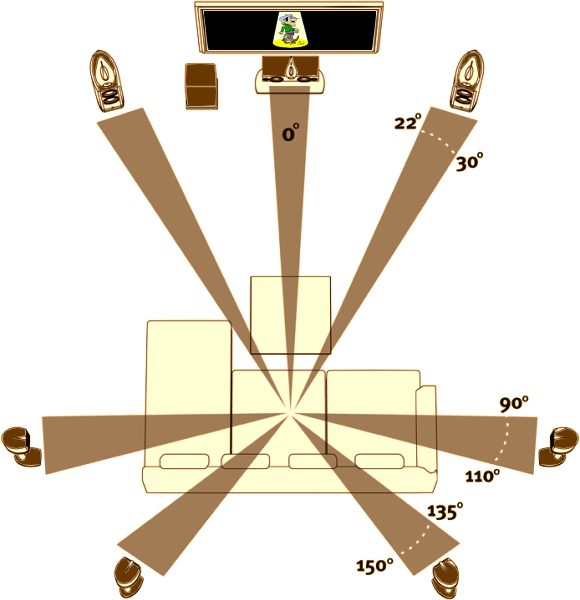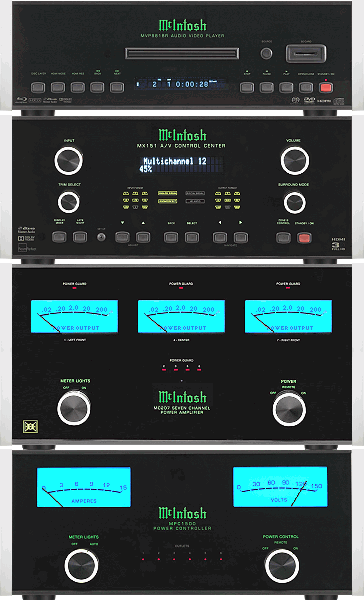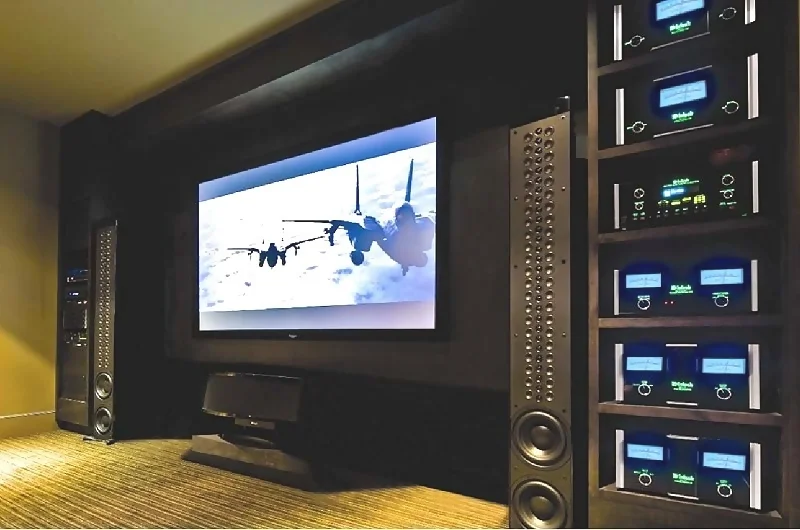Multimedia devices & speakers |
|
|
Playback sound familiar from the days of our grandfathers, radio, amplifier and speaker in one cabinet with possible embedded turntable to play music recorded on polyvinyl plates, has evolved using modern technologies. The first improvement was the sound stereo system that used two audio channels, and then in quadraphonic system with two additional background on the stereo channels, both based on the mechanical reproduction of records on polyvinyl plates. Stereo systems have proved quite sufficient for home listening conditions, but not in theaters, for which it was developed quadraphonic system that allowed two additional background channels. These technologies are called 'Dolby Stereo' and 'Dolby Surround', originally created in the 'Dolby Laboratories, Inc.'.
Advances in systems for sound reproduction with regard to creating spatial (surround) atmosphere brings 'Dolby Pro Logic' technology. Stereo system is enriched with three additional independent channels - five independent channels: left, right, center, and two background (surround) channels. The advantage of this system was its simplicity because it basically requires the simplest electronic devices. For example, the center channel signal is the sum of the left and right channels signals, and back channels used the anti-phase signals and a limited frequency band. Then the scheme is extended an additional (subwoofer) channel exclusively for reproducing sounds very low frequencies.
With the introduction of digital signal processing there was a large shift in the quality of creating spatial sound field. Developed 'Dolby Digital' of the 1997th The algorithm that uses AC3 for multichannel audio coding, but capacity constraints of CD media, is reason for use data reduction based on psychoacoustic, something like 'mp3' audio coding system. DVD format gives new impetus to the development of 'Dolby Digital' system. All channels are sent separately, or no crosstalk channels. 'Subwoofer' has a separate channel, and not derived from the left and right, allowing the separate encoding and adding better effects, and it is possible that the dialogues have a uniform volume. The system consists of 6 channels, central, front left and right and the left and right sides, and an additional channel for 'subwoofer', and has been labeled 5.1 system. According to Figure 3.1a only difference is that no two rear speakers. 'Subwoofer' can be placed anywhere because human auditory system is unable to determine the direction of sounds is very low frequencies and are usually very large speakers with woofer with its own amplifier in its casing. What is a 'subwoofer' over in the corner of the stronger is the 'bass' (low frequency sound) but its definition is weaker.
Further improving the acoustics of space was obtained by introducing BR media and the left and right channels of the background into the system, a sound system 7.1 whose concept is shown in Figure 3.1a. As the center speaker reproduces most of the signal transmitted because virtually all audible range, its quality is more important than features of rear speakers. But it is not only 'Dolby' dealt acoustic space. There's more competition, but their system is the most common. It's very prevalent later developed DTS (Digital Theater Systems) system as well as 'Dolby' supports stereo, 5.1, 6.1 (intermediate stages of development) and 7.1 sound concepts, and to a lesser extent SDDS (Sony Dynamic Digital Sound) system that has a label 5/2.1, or five speakers in the front and two in the back. At BR media can find any of the above described system.

|
|
| Figure** 3.1 Sound System 7.1 / Speakers. ( + / - ) |
No matter how much technology has progressed and the TV no matter how great diagonal screen without quality amplifiers and speakers sound system of home theater experience just is not complete. Share of sound in home theater experience is greater than 50%. Figure 3.1a shows the distribution of speakers and TV for 7.1 multimedia system. Compared to the 5.1 system it differs in that it has no background speakers, and is quite extensive as record audio content on the media because BR is sufficient for multimedia sound experience. According to the size of sofa, room and home theater would have a size slightly larger than 7 m × 5 m × 3 m (L×W×H). Distribution for 7.1 speaker system is shown in Figure 3.1a, and based on consideration RMS power in the previous description, speakers of a sound system that would support the acoustics of the room are shown in Figure 3.1b. Multimedia is more and more present in the home system for fun, games and entertainment, especially as part of a home (SOHO) computer network.
Speakers presented the product of the company 'McIntosh' and represent some sort of 'middle' precisely attuned their offerings for the home theater. In Figure 3.1c shows the cross-section of one speaker box, rated power 600 W, making better compared to the examples in Figure 3.1b. Power marked by speakers at Figure 3.1b are their rated power, and system belongs to the 'weak', as it has with much greater power output of the order 'kW', such as speakers are shown in Figure 3.4. Their recommendation according Figure 3.1b is that the power amplifier for the front speaker array is not less than 100 W, and for the side and rear speakers are recommended amplifiers at least 50 W. 'Subwoofer' has its own amplifier in its base. The company has a tradition of more than 50 years and the products made by quality are at the top offers in the industry. Price of smallest speakers at Figure 3.1b is about $ 1,000, the left and right channels around $ 2'000, central around $ 3'000 and 'subwoofer' about $ 2'500, and the price of the speaker at the Figure 3.1c is about $ 3'500, a tremendous number which varies to a large extent on the dealer. It is good to ask yourself and the dealer has the equipment used (second hand).
Shown in Figure 3.2a is that everything should have a 'weaker' Hi‑Fi (high fidelity) multimedia system of the company 'McIntosh', designed specifically for home theater.

|

|
|
| Figure* 3.2 McIntosh system. ( + / - ) |
At the bottom is a device for monitoring the power supply (Power Controller) 'McIntosh MPC1500'. The basic purpose is that through toroidal transformer electrically disconnected power source from the devices and thus solve the problem of grounding. Besides that 'clean' voltage of harmonic components and regulate voltage deviation of ±2.5%. Rated power is about 1500 W. Serves up to 12 devices through connectors on the rear panel. In addition to the above, in particular the control electronics through separate connectors are all connected devices that serve to get feedback from them. An effective way to drastically eliminate electrical noise of power source and 'buzz' of the amplifier. Price is around $ 4'000.
On the above described device is 'McIntosh MX151' home theater control center. Basically it is a preamplifier that processing incoming analog signal or decoding of digital signal. The device has a built-in microphone in order to automatically perform corrections of sound spectrum ('Room Perfect' technology), HDMI connectors and other connectors standard for interconnecting devices and a multitude of built-in controls over the use of the device, or the device is operated via remote control, and the parameters can be read at the display in the middle of the front panel. Using the included microphone, 'RoomPerfect' technology will model using three-dimensional audio analysis of the room, even if the height speakers are not equally placed, and balances the system. For traditional stereo music lovers, the device has a mode to work with two analogue channels are switched off when the digital processing, which reduces the 'electronic noise' and provides extra quiet environment. Basic parameters of the preamplifier are shown in Figure 3.3b. Price is about $ 12'000.
On the preamplifier is 7 channel power amplifier 'McIntosh MC207', rated power of 200 W per channel, designed specifically for home theater with the basic purpose to serve the speakers shown in Figure 3.1b. Amplifier serves voltage source of ±62 V DC with two electrolytic capacitors of about 67'000 µF filtering corrected voltage. Supply of DC voltages is sufficiently high to achieve quality dynamics. The large dynamic range makes it possible to correctly reproduce the short and large 'peaks' of signal, without cutting the peak amplitude of the signal (clipping). If the peak signal 'cut', the resulting 'flat' part of the signal is detected as the DC current causing the reactance of the speaker has no relevance, the speaker impedance decreases rapidly and may overload the output transistors and speaker damage. Amplifiers operating in the ' AB ' class and have control of BIAS current through the output transistors, when realizing that greater linearity, particularly the small signal gain. Each channel has two symmetric (push-pull) branches with 4 transistors in parallel in each branch. No remote control :-). Basic parameters of the amplifier are shown in Figure 3.3a. In the bottom of Figure 3.3a are shown the amplifier input connectors (XLR connectors) for supplying the signal from the preamplifier, as well as multiple contact connector (DB25 connector) for signal transmission and surveillance special cable connects with those in the same preamplifier. Amplifier parameters are shown in the same figure. Price is around $ 6'000.
At the amplifier is 'McIntosh MVP881BR' universal device to read CD, DVD and BR content (player). Input tray is not made of plastic but from cast aluminum, and the vibrations caused by rotating media have effectively absorbed. Use the built-in software for decoding SACD, DVD-A, DVD-V, CD, DVD+/-RW, Audio CD-R/RW, MP3, CDR/RW, DivX, WMA, HDCD, JPEG images, Kodak picture CD and Fuji CD contents in color. Supports two stereo channels with 5.1 system, therefore 7.1 coding system of music. It has a built-in 24-bit decoders that operate at a frequency up to 192 kHz sampling. Supports 'Dolby' and 'DTS' multimedia playback systems. It has a remote control. Price is around $ 8'000.
Besides the above is available a few specific devices, like the classic turntable, but the most interesting is the ability to use the iPad and iPhone. Truly versatile modes of system control. What it should be mentioned, which should be taken into account, the available dynamic range of the power amplifier. In Figure 3.2b shows the measuring instruments (VU meter) three different amplifiers rated power of 200 W, 600 W and 1200 W, but below the scale of each of them can read how much power available to process some powerful pulse without distortion. Of course, the key role in this has a voltage output transistors.

|
| Figure* 3.3 Specification of multimedia power amplifier and control preamplifier. ( + / - ) |
The following Figure 3.4a shows the the room designed for multimedia playback. In the picture is dominated a large HD television and 'McIntosh' multimedia system consisting of a multitude of individual components but also more powerful than previously described.

|
| Figure** 3.4 Multimedia room / Acoustic walls. ( + / - ) |
It can be noticed the distinctive appearance of the floor, from which it can be concluded that the room acoustically 'processed'. A number of types of materials and their design is used for the processing of the room, so that the end result may seem strange indeed, as shown in Figure 3.4b. The most important thing is to get to a reasonable reflection. Part of reflection must remain as not to lose the echo. The cost of such treatment facilities is certainly not small.
The system for home theater have to be expensive - does not have to. The following figure shows the 5.1 speaker system incorporated in a single chassis that is placed below the TV set. These systems vary considerably in quality, characteristics (2.1 / 3.1 / 5.1 / 7.1) and hence the price (from $ 100 to over $ 1'000) but they are a more practical solution than previously described. Can create a very acceptable spatial acoustic for the average user.

|
| Figure 3.5 Soundbar. |
Line Speaker System (Soundbar) in the cheaper varieties will have a 'subwoofer' as a separate unit in relation to the system as shown in size and will be a little thinner. Power sound system of a hundred watts RMS (25 watts for the subwoofer and 15 watts for other individual speakers) is quite acceptable. The principle of operation is based on the guidance of sound in different directions across the room so that the reflected sound waves from the side and rear walls forming spatial sound image. In this respect, smart electronics performs required phase shift in the signal for each built-in speaker. Built-in microphone to analyze the room acoustics and a self-adjusting system is special feature which will have a more expensive system. If the system has a S/PDIF optical input, connect to the example in Figure 3.1 for a multimedia device is more than simple.
SUMMARY:
From the above it can be concluded that the quality of playback of multimedia content is very expensive pleasure. But basically, the price is one little thing to say 'tycoon'. And for just a 'mortals' are too expensive and produces of firm as 'Sony' or 'Samsung'. Surely that can be bought and components that are much cheaper, and if the listener is not music 'gourmet' and who does not have very keen hearing, there is no need for a system such as described, but the system that he is financially acceptable. Of course, Do not believe the boxes in which are the two small speakers in a plastic casing that says you belong to the Hi‑Fi class and develop 200 W. In particular, one should be careful when purchasing amplifiers ' D ' class, especially if they are small. Power amplifier of ' D ' class, especially with the built-in SPS energy source can develop very high power, and well before purchasing such a system is to listen to some quality music notation, because despite the aural impressions 'fascinating' effect can be very terrible. It remains true that the general principle of the device is better if it is heavier, and this is the first 'of speed' measure of product quality. Power amplifier at Figure 3.2 weighs over 35 kg.
If taking into account the average listener in musical tastes of the Croats, and the dynamic range of content that is 'recorded' at media exactly matches to the quality of content for the music kind of 'rant', that is almost none, then described system in an apartment does not serve anything except for the hassle neighbors. For vinyl LPs can safely say that they those labeled 'CBS', packaged in a hard cover covered with cellophane, had a greater dynamic range than those of the Croats marked 'Jugoton'. It is not likely that the Croats something essential change even now using CD / DVD media.
Small theoretical curiosity for the end. Speaker cone during vibrations created two sound waves, the front and rear, which are in antiphase. If these two waves are added together to abolish. Ideal speaker stands in the opening infinitely large flat surface, and the rear sound wave is no opportunity to influence the space in front of the speaker cone. Sound box has a duty to wave on the back sides of the speaker cone is absorbed and so 'act out' infinite surface, or wave from the rear with labyrinth inside the box ejected through a 'hole' in the box so that it is in the same phase as the wave that caused the front cone speakers. Size of speakers cones is inversely proportional to the operating frequency. Well if you look at Figure 3.1b, it is not difficult to conclude that the frequencies are predicted for differently size of cones of center speaker. As the internal interconnected electrical filters is not the topic of the content.
|
|
|
Citing of this page: Radic, Drago. " IT - Informatics Alphabet " Split-Croatia. {Date of access}. <https://informatics.buzdo.com/specific/file>. Copyright © by Drago Radic. All rights reserved. | Disclaimer |